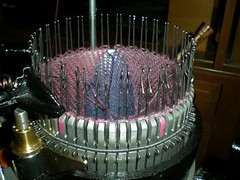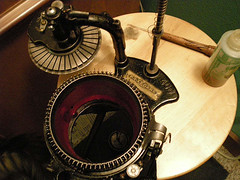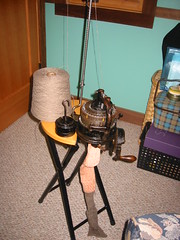 © February 24, 2009, Amelia of AskTheBellwether.com
© February 24, 2009, Amelia of AskTheBellwether.comSock machines, by definition, are almost always second-hand. There is one maker of new ones currently, the New Zealand Auto Knitter (NZAK) made in, you guessed it, New Zealand! It is very nice to have a completely new machine -- though they come with the same learning curve as the others (same as a spinning wheel, grin -- ya gotta learn to spin before the machine will make yarn).
Let's call that the first tier. Second tier -- just as good, really, but not brand-spanking-new, is a fully restored machine, restored by a professional. These are often powder coated too, very shiny and clean. My first machine was restored by Pat Fly -- wonderfully perfect. Jacqui Grant, maker of the NZAK, also restores machines very nicely, I've seen some of her restorations at local crank-ins, and on e-Bay. There are other restorers as well -- Donna Peters, Roxana Baechle, John Loeffelholtz, Old Tyme Stockings, Plum Cottage Crafts, and likely others I have not run across or have forgotten (I'm sorry!) So, how do you find these? The most reliable place to find a restored-and-tested machine is on one of the Yahoo group sale lists: Sock Knitting Machine Swap Shop and Sock Knitting Machine Friends (both sales and discussions); or on the Ravelry CSM Sales and Swaps group. Often the restorers have waiting lists, though, so putting an ISO/wanted call out on a list may be advisable, once you know the machine you want.
 Which machine should you want? Really, that's a personal thing, just like with wheels. Legare and Auto Knitter are the most-discussed, but there are also Creelman, Gearheart, Beehive (UK), and others. Maybe you want an "odd" one, a really rare one, or simply a mainstream one. Cylinder size might matter to you (number of slots) -- 72/36 or 60/30 works well for most sock yarns and medium sized socks, but if you want kids' socks, you might need to wait until a smaller-diameter machine or one with a compound cylinder comes up for sale. 100 slot cylinders are fairly rare in old machines.
Which machine should you want? Really, that's a personal thing, just like with wheels. Legare and Auto Knitter are the most-discussed, but there are also Creelman, Gearheart, Beehive (UK), and others. Maybe you want an "odd" one, a really rare one, or simply a mainstream one. Cylinder size might matter to you (number of slots) -- 72/36 or 60/30 works well for most sock yarns and medium sized socks, but if you want kids' socks, you might need to wait until a smaller-diameter machine or one with a compound cylinder comes up for sale. 100 slot cylinders are fairly rare in old machines.Okay, on with my tiers. The third tier would be a cranker selling one of their working machines. I bought one this way, it was in excellent shape. The cranker was active on the lists, so I knew her comments on it would be accurate and reflect the machine. Again, the lists above are great for this.
The final places to look are a mixed bag: may be terrific, may be disfunctional. Those are eBay, your local craigslist, estate sales, and old barns.
I've heard of sock machines showing up "in wooden crates" (which is how they were shipped when they were made back in the late 1800's, early 1900's) in antique shops, estate sales, and old barns -- but not here, all the stories seem to come from Canada and the east coast. Those may have been in the crate a loooong time, so check for true roundness in the cylinders, that the cylinders come out of the machine, and the quality of the metal. Some machines were made from cheap metals and will be corroded or have bent off-true.
Craig's List may be somewhere to watch for them too. Check out your local Craig's List or use http://www.craigshelper.com/ to search all of the ones within 250 miles of you. I'd tend to stick to local machines where the seller can show you how to use it -- that will show you also that the machine works. If they don't know, then you are taking a risk. Bonnie Smola offers a wonderful interactive book on CD, that shows you the ins-and-outs of taking a machine apart, cleaning it, putting it back together, and knitting on it. Very worth while when purchasing an unknown machine.
 Sock machines show up all the time on eBay. These can be a pretty mixed bag. Some are being sold by professional restorers, in restored and working condition. Some are cleaned up but not knit on -- remember, if the seller says the crank turns easily, they may or may not be actually knitting on the machine. They may simply be cranking the gears without even a cylinder in the machine. The machine being sold may actually be a mixed set of parts from different machines -- that might be okay, if the parts are, say, all Legare parts; but if they are from different models or makers, that may or may not work.
Sock machines show up all the time on eBay. These can be a pretty mixed bag. Some are being sold by professional restorers, in restored and working condition. Some are cleaned up but not knit on -- remember, if the seller says the crank turns easily, they may or may not be actually knitting on the machine. They may simply be cranking the gears without even a cylinder in the machine. The machine being sold may actually be a mixed set of parts from different machines -- that might be okay, if the parts are, say, all Legare parts; but if they are from different models or makers, that may or may not work.For both craigslist and eBay machines, I'd recommend that you ask for advice on one of the Sock Machine lists -- there's a specific thread on Ravelry's Circular Sock Machine group for eBay and craigslist help. The folks who track that discussion can let you know if they see parts missing, mis-matched parts, or anything else not normal and expected.
I'd also recommend going to a crank-in near you (these tend to be announced on local CSM groups -- look for one near you on Yahoo -- and occasionally also the bigger CSM groups on Yahoo). The Circular Sock Machine Society of America has an annual conference that moves around the USA, if it's near you, that is a must-see event, almost always with machines for sale available. With a room full of crankers, you can be sure they will be demo'able, working machines. These events will let you see a variety of models and ask questions to help you decide what machine is right for you.
What does a sock machine come with? Some come with ribbers, some do not. It's very difficult to find a ribber for a ribber-less machine, so if you think you'll want to rib, find a machine with a ribber. There are many things (including socks!) you can make without a ribber, so you decide. Ribbers add to the value (and cost) of the machine. Some have multiple cylinders and ribber plates. They should include a weight stack, stitch picker-uppers/heel weight hangers, setup basket, buckle, and needles (though often with old machines, not restored, they are original and not in great shape). Complete original machines may include a cone winder, wooden cones, skeiners, and possibly sock blockers. Restored machines often come with heel forks and may have replacements for things like setup baskets and buckles if the restorer has built a better mousetrap -- I personally prefer big blue laundry clips over the original metal buckles, and knit my own setup baskets instead of using the original metal one.
There are plenty of original manuals online in Pat Fly's archive -- even if it's not your machine brand, it can provide you with basic instructions. The variety of books available has been increasing: Jenny Deters has written two, one on lace structures for detail work in socks and one on socks & more (non-socks!) to make on your machine; Donna Peters and Laura of Handwerks have both written nice introductory books on using sock machines without ribbers. Richard Candee has written a thorough historical e-book about sock machines, The Hand-Cranked Knitter and Sock Machine.
Videos also exist -- the NZAK video is available on youTube. Roxana Baechle and John Loeffelholtz have both produced videos. Roxana's series shows a wide variety of techniques for socks and a good collection of non-socks. Check the sale lists and eBay for those.
It's possible sock machines could turn up on the same websites that I listed for second-hand spinning wheels; though honestly I don't recall seeing any on them when I've visited them in the past.
~~
The machines shown here are: (1) My Black first-model-year NZAK; (2) a Legare 400 - possibly from eBay, that I bought and cleaned up (3) a Creelman I bought from eBay and cleaned up. I've had machines from Pat Fly, John L., and other crankers as well along the way, very happily, as well as some eBay machines that didn't end up functional, but luckily I didn't bid so much that it was painful to turn them into spare parts for other machines. I'm currently down to "just" my NZAK, with a very nice set of cylinders including a compound cylinder.
I ran across a fun new-to-me blog today, Circular Sock Machine FAQ. Nice way to keep up with CSM community announcements and useful pointers to posts in other blogs ... like I Frogged It, who has had some fun patterns up recently, for leg warmers and cup cozies.
~~
posted 24 February 2009 at http://askthebellwether.blogspot.com/
